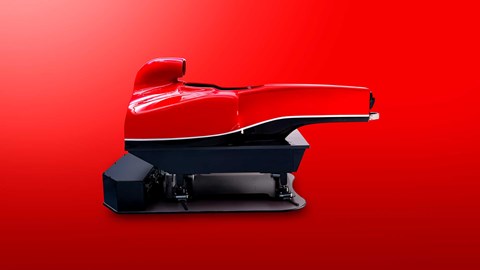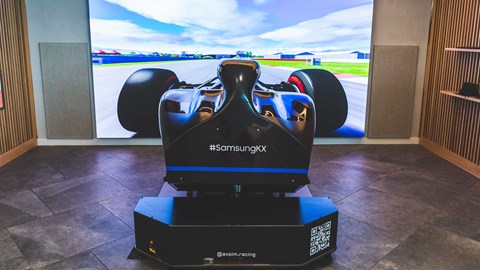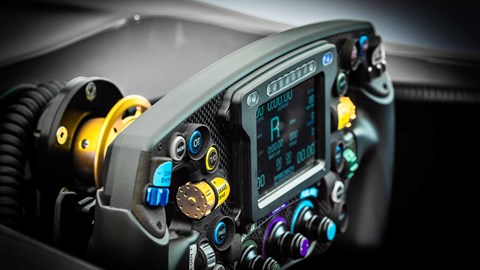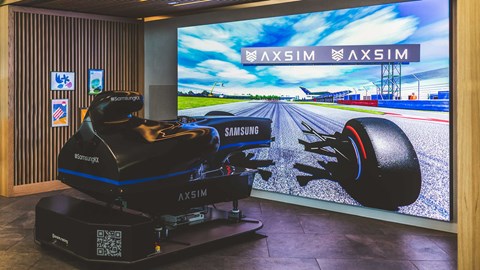► We drive a £129,000 sim
► Uses military tech to ‘create’ g-forces
► The most convincing sim you can buy?
Strapping into Cranfield Simulation’s Axsim rig is a bit like getting your blood pressure taken, only with a five-point racing harness instead of an air-inflated armband. Featuring high-end components and the company’s military-focused innovations, the Axsim is the closest you can get to driving a high-downforce car short of paying for a go in a Williams or Haas. And it’s all down to how it conveys g-forces.
Most moving sims – often on a sled or hexapod – give the initial feeling of g-forces, but they’re unable to sustain them for a realistic amount of time. The result? You end up losing that sense of movement, and the sense of immersion is lost. Take Spa’s Pouhon, for example; lots of rigs can give you the jolt of flicking the car into the fast double left, but they’re unable to recreate the sensation of the car loading up g-forces throughout the corner. That feeling of five times your body weight trying to escape the cockpit is exactly what the Axsim nails.

How does it work?
Like other sims, the Axsim sits on a directional sled and uses a D-Box for roll and pitch, and it also runs Assetto Corsa. However, its most impressive tech is nestled in and around the driver’s seat, reclined in this case to echo the driving position of a Formula 1 car.
Modern F1 cars get compared to fighter jets all the time; and it turns out fighter pilot training technology is exactly what you need simulate driving them. Cranfield Simulation counts 21 different armed forces among its clients and has contributed to two million hours of simulator operation for jets from the Typhoon to the Harrier. Its G-Seat was first used to recreate the feeling of sustained high g-forces during air combat – and that tech has found its way the company’s driving sims.

The Axsim’s seat is packed with airbags, which are manipulated depending on what your car is doing. Powered by a network of transparent tubes, they create somatic, tactile feedback that elevates the Axsim from impressive to eerily realistic.
The idea is simple in theory: instead of g-forces pushing you against the cockpit, the cockpit pushes against you. The effect is the same, and the clever bit is working out just how much pressure is needed and where.
What’s it like?
In practice it’s a game changer. At lower downforce tracks like Brands Hatch, the Axsim’s D-box nails most of it; kerbs shake your entire body and the high-spec wheel transmits everything you need to know about the road surface. The pedals feel accurate too, though the racing-spec brake takes some getting used to. It’s only in the two swooping rights of Hawthorns and Westfields that you start to feel the g-seat at work.

Where the Axsim – and the cars it emulates – really shines, is on high-downforce tracks that show the sheer grip of modern single-seaters. Silverstone’s Maggots and Becketts become an assault on the senses, as you wrestle the car to every kerb, feel the grip in your hands and then sense your shoulders, back and legs pressured as the g’s load up and switch to either side.
High-downforce cars are notoriously snappy when their aero does let go, and the Axsim nails that, too; a curved rail system throws in some yaw to give the impression of the back snapping. During my drive, it happens several times on exit, and I find myself reacting to the feeling of the snap rather than the visual cues I get on the big screen.
Of course, the sled itself is only half of the equation, and I tried it with Samsung’s latest and greatest display technology. Called The Wall, its modular LED system works more like an illuminated puzzle and less like a traditional TV. It can be built to any dimension you need, and here it was both extremely large but also of a good pixel density.

Verdict
Like most full-size sims, the Axsim is aimed at racing drivers and high-worth individuals, but both would do well to get the £129,000 unit rather than the ‘cheaper’ £36,000 unit, as the former comes with the G-Seat. In the same way that force-feedback only becomes essential after you’ve experienced it, the same can be said of Cranfield’s G-Seat technology. It delivers the same visceral and engaging feel as other sims I’ve tried, but its ability to emulate the feel of g-forces through high-speed corners puts it above everything else.
It’s now available to view and even try at Samsung’s KX flagship store in the Coal Drops Yard, London.